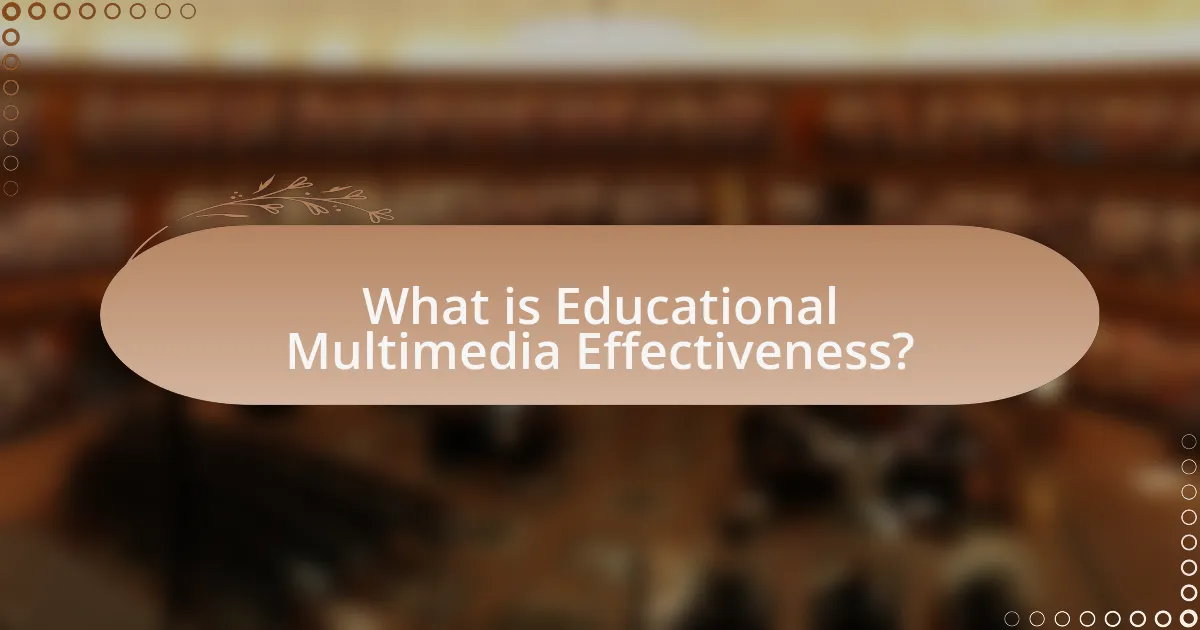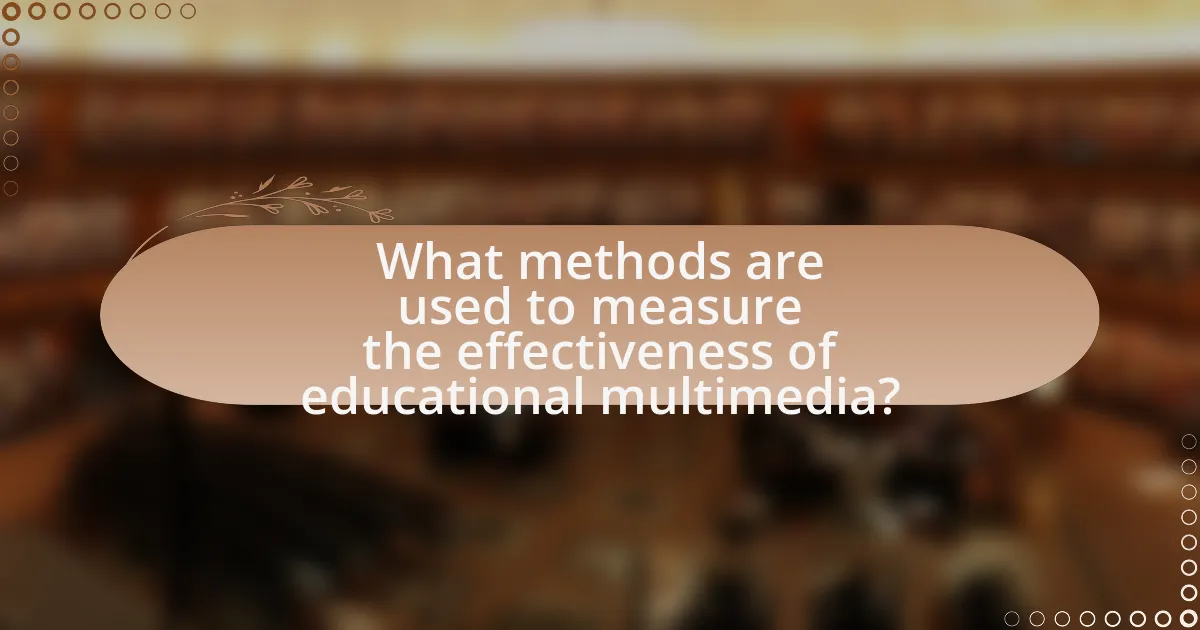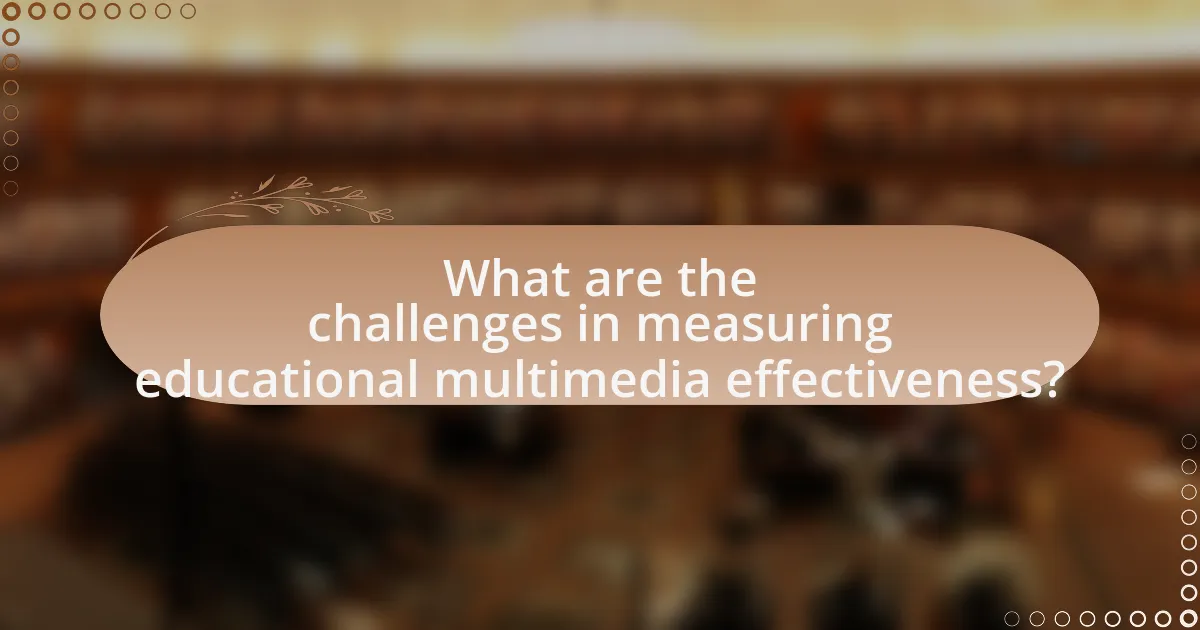Educational multimedia effectiveness refers to how multimedia resources enhance learning outcomes and engagement in educational environments. The article outlines the criteria for evaluating this effectiveness, including engagement, learning outcomes, usability, and content quality, and discusses the importance of measuring effectiveness to improve educational practices. It highlights various methods for assessment, including quantitative and qualitative approaches, and addresses the challenges educators face in measurement, such as biases and limitations of current tools. Additionally, the article provides practical tips for implementing effective measurement strategies and resources available for educators to enhance their measurement practices.

What is Educational Multimedia Effectiveness?
Educational multimedia effectiveness refers to the degree to which multimedia resources enhance learning outcomes and engagement in educational settings. Research indicates that educational multimedia can improve retention rates, understanding, and motivation among learners, as evidenced by studies showing that students exposed to multimedia presentations scored higher on assessments compared to those receiving traditional instruction. For instance, a meta-analysis by Hattie (2009) found that the use of multimedia in education has an effect size of 0.62, indicating a significant positive impact on student learning.
How is effectiveness defined in the context of educational multimedia?
Effectiveness in the context of educational multimedia is defined as the degree to which multimedia resources enhance learning outcomes and engagement among students. This definition is supported by research indicating that multimedia elements, such as videos, animations, and interactive content, can significantly improve retention and understanding of complex concepts. For instance, a study by Mayer (2009) in “The Cambridge Handbook of Multimedia Learning” demonstrates that students who learn through multimedia presentations perform better on tests compared to those who learn through traditional methods, highlighting the positive impact of effective multimedia on educational success.
What criteria are used to evaluate educational multimedia effectiveness?
The criteria used to evaluate educational multimedia effectiveness include engagement, learning outcomes, usability, and content quality. Engagement assesses how well the multimedia captures and maintains learners’ attention, which is crucial for effective learning. Learning outcomes measure the extent to which the multimedia facilitates knowledge acquisition and retention, often evaluated through assessments or performance metrics. Usability examines how easily learners can navigate and interact with the multimedia, impacting their overall experience and learning efficiency. Content quality evaluates the accuracy, relevance, and appropriateness of the information presented, ensuring it aligns with educational objectives. These criteria are supported by research indicating that effective multimedia enhances learning experiences and outcomes when they meet these standards.
How do these criteria impact learning outcomes?
The criteria for measuring the effectiveness of educational multimedia significantly impact learning outcomes by determining the quality and relevance of the content delivered to learners. High-quality multimedia that aligns with educational objectives enhances engagement, retention, and understanding, leading to improved academic performance. For instance, research by Mayer (2009) in “Multimedia Learning” indicates that well-designed multimedia presentations can increase retention rates by up to 50% compared to traditional methods. This demonstrates that adherence to effective multimedia criteria directly correlates with positive learning outcomes.
Why is measuring effectiveness important?
Measuring effectiveness is important because it provides a clear assessment of how well educational multimedia achieves its intended learning outcomes. By evaluating effectiveness, educators can identify strengths and weaknesses in their multimedia resources, ensuring that they meet educational goals. Research indicates that effective measurement can lead to improved student engagement and learning retention, as evidenced by a study published in the Journal of Educational Technology & Society, which found that multimedia tools significantly enhance learning when their effectiveness is regularly assessed.
What are the potential consequences of not measuring effectiveness?
Not measuring effectiveness can lead to significant negative outcomes, including wasted resources and missed opportunities for improvement. Without assessment, educational multimedia initiatives may continue to operate without understanding their impact on learning outcomes, resulting in ineffective strategies being employed. Research indicates that organizations that do not evaluate their programs often experience stagnation in performance and fail to adapt to the needs of their audience, as they lack data-driven insights to inform decision-making. For instance, a study by the American Educational Research Association found that educational programs that incorporate regular effectiveness measurements are 30% more likely to achieve their intended learning goals compared to those that do not.
How can effective measurement improve educational practices?
Effective measurement can significantly enhance educational practices by providing data-driven insights that inform instructional strategies. By utilizing assessments and analytics, educators can identify student learning gaps, tailor interventions, and improve curriculum design. For instance, a study by Hattie (2009) in “Visible Learning” demonstrates that feedback and formative assessments can lead to a 0.7 effect size on student achievement, indicating substantial improvement. This evidence underscores the importance of effective measurement in refining teaching methods and fostering student success.

What methods are used to measure the effectiveness of educational multimedia?
Methods used to measure the effectiveness of educational multimedia include quantitative assessments, qualitative evaluations, and mixed-method approaches. Quantitative assessments often involve pre-tests and post-tests to measure knowledge gain, while qualitative evaluations may include surveys and interviews to gather user feedback on engagement and usability. Mixed-method approaches combine both quantitative and qualitative data to provide a comprehensive understanding of multimedia effectiveness. Research has shown that using these methods can lead to more accurate evaluations; for instance, a study by Hattie (2009) found that multimedia learning can significantly enhance student achievement when assessed through varied methodologies.
How do qualitative methods contribute to effectiveness measurement?
Qualitative methods contribute to effectiveness measurement by providing in-depth insights into user experiences and perceptions. These methods, such as interviews and focus groups, allow researchers to gather rich, contextual data that quantitative measures may overlook. For instance, qualitative feedback can reveal how educational multimedia impacts learner engagement and comprehension, which are critical factors in assessing effectiveness. Studies have shown that qualitative evaluations can uncover nuances in user interactions, leading to more tailored and effective multimedia designs.
What types of qualitative data are most useful?
The most useful types of qualitative data in measuring the effectiveness of educational multimedia include user feedback, interviews, focus groups, and observational data. User feedback provides insights into learners’ experiences and satisfaction levels, while interviews can reveal deeper understanding of individual perspectives. Focus groups facilitate discussions that uncover collective opinions and attitudes towards multimedia content. Observational data allows researchers to assess engagement and interaction with the educational materials in real-time. These qualitative data types are essential for capturing the nuances of learner experiences and informing improvements in educational multimedia design.
How can interviews and focus groups enhance understanding?
Interviews and focus groups enhance understanding by providing qualitative insights into participants’ thoughts, feelings, and experiences. These methods allow researchers to gather in-depth information that quantitative data cannot capture, revealing nuances in user interactions with educational multimedia. For instance, a study by Krueger and Casey (2015) highlights that focus groups can uncover specific user preferences and challenges, leading to more effective multimedia design. This qualitative feedback is essential for tailoring educational content to meet learners’ needs, ultimately improving the effectiveness of educational multimedia.
What role do quantitative methods play in measuring effectiveness?
Quantitative methods play a crucial role in measuring effectiveness by providing objective data that can be statistically analyzed. These methods enable researchers to assess the impact of educational multimedia through metrics such as test scores, completion rates, and engagement levels. For instance, a study published in the Journal of Educational Psychology found that students using multimedia resources scored 20% higher on assessments compared to those using traditional methods, demonstrating the effectiveness of such tools. By employing quantitative methods, educators can make data-driven decisions to enhance learning outcomes and optimize multimedia resources.
What metrics are commonly used in quantitative analysis?
Common metrics used in quantitative analysis include mean, median, mode, standard deviation, variance, correlation coefficients, and regression coefficients. These metrics provide essential statistical insights into data sets, allowing researchers to summarize, analyze, and interpret numerical information effectively. For instance, the mean offers an average value, while standard deviation measures data dispersion, both critical for understanding educational multimedia effectiveness. Correlation coefficients quantify the relationship between variables, which is vital in assessing how different multimedia elements impact learning outcomes.
How can statistical analysis provide insights into effectiveness?
Statistical analysis provides insights into effectiveness by quantifying the impact of educational multimedia on learning outcomes. By employing methods such as regression analysis, researchers can determine the relationship between multimedia usage and student performance metrics, such as test scores or retention rates. For instance, a study published in the “Journal of Educational Psychology” found that students who engaged with interactive multimedia scored 20% higher on assessments compared to those who used traditional methods, demonstrating a clear link between multimedia effectiveness and improved learning outcomes. This empirical evidence supports the assertion that statistical analysis is crucial for evaluating the effectiveness of educational multimedia.

What are the challenges in measuring educational multimedia effectiveness?
Measuring educational multimedia effectiveness presents several challenges, primarily due to the variability in learning outcomes and the subjective nature of multimedia experiences. One significant challenge is the difficulty in establishing clear, quantifiable metrics for success, as educational outcomes can vary widely among different learners based on their individual backgrounds, learning styles, and prior knowledge. Additionally, the integration of multimedia into educational settings often lacks standardized assessment tools, making it hard to compare effectiveness across different platforms or content types. Research indicates that factors such as engagement levels, cognitive load, and the alignment of multimedia content with learning objectives further complicate the measurement process. For instance, a study by Mayer (2009) highlights that multimedia learning effectiveness is influenced by how well the content is designed to facilitate understanding, which can be subjective and context-dependent.
What common obstacles do educators face in measurement?
Educators commonly face obstacles in measurement such as lack of standardized assessment tools, insufficient training in data analysis, and time constraints. The absence of standardized tools can lead to inconsistent evaluation of educational multimedia effectiveness, making it difficult to compare results across different contexts. Additionally, many educators report feeling unprepared to analyze data effectively, which hinders their ability to draw meaningful conclusions from assessments. Time constraints further exacerbate these issues, as educators often struggle to find the necessary time to implement and analyze assessments thoroughly. These challenges collectively impede the accurate measurement of educational multimedia’s impact on learning outcomes.
How can biases affect the measurement process?
Biases can significantly distort the measurement process by introducing systematic errors that affect the accuracy and reliability of data collected. For instance, confirmation bias may lead researchers to favor data that supports their preconceived notions about educational multimedia, while neglecting contradictory evidence. This can result in skewed results that do not accurately reflect the true effectiveness of the multimedia being evaluated. Additionally, selection bias can occur if the sample of participants is not representative of the broader population, leading to findings that cannot be generalized. Studies have shown that biases in measurement can lead to misinterpretations of educational outcomes, ultimately affecting decision-making and resource allocation in educational settings.
What limitations exist in current measurement tools?
Current measurement tools for evaluating educational multimedia effectiveness face several limitations, including a lack of standardization, difficulty in capturing qualitative data, and potential biases in user feedback. The absence of standardized metrics makes it challenging to compare results across different studies or tools, leading to inconsistent findings. Additionally, many tools primarily focus on quantitative metrics, such as test scores or completion rates, which may overlook important qualitative aspects like user engagement and satisfaction. Furthermore, user feedback can be influenced by personal biases or external factors, which may skew the results and affect the reliability of the measurements. These limitations hinder the comprehensive assessment of multimedia effectiveness in educational settings.
How can these challenges be overcome?
To overcome the challenges in measuring the effectiveness of educational multimedia, implementing a combination of quantitative and qualitative assessment methods is essential. Quantitative methods, such as pre- and post-tests, can provide measurable data on learning outcomes, while qualitative methods, like student feedback and observational studies, can offer insights into user engagement and satisfaction. Research by the U.S. Department of Education indicates that multimedia tools can enhance learning when properly evaluated, highlighting the importance of a mixed-methods approach to capture a comprehensive view of effectiveness.
What best practices can enhance measurement accuracy?
To enhance measurement accuracy in evaluating the effectiveness of educational multimedia, it is essential to implement standardized measurement tools and protocols. Standardized tools, such as validated surveys and assessment rubrics, ensure consistency in data collection, which minimizes variability and bias. Research indicates that using reliable instruments, like the Multimedia Learning Assessment Scale, can significantly improve the precision of measurement outcomes. Additionally, conducting pilot tests before full-scale implementation allows for the identification and correction of potential issues in the measurement process, further enhancing accuracy.
How can technology aid in overcoming measurement challenges?
Technology can aid in overcoming measurement challenges by providing advanced data analytics tools that enhance the accuracy and efficiency of educational assessments. These tools, such as learning management systems and adaptive testing software, enable real-time data collection and analysis, allowing educators to track student performance and engagement more effectively. For instance, a study by the Bill & Melinda Gates Foundation found that data-driven decision-making in education can lead to improved student outcomes, demonstrating the effectiveness of technology in addressing measurement issues.
What are some practical tips for measuring effectiveness?
To measure the effectiveness of educational multimedia, utilize specific metrics such as learner engagement, knowledge retention, and user feedback. Engaging learners can be assessed through analytics that track interaction rates, such as time spent on tasks and completion rates, which provide insight into how well the multimedia captures attention. Knowledge retention can be evaluated through pre- and post-assessments, allowing for a comparison of learner performance before and after exposure to the multimedia content. User feedback, collected through surveys or interviews, offers qualitative data on the perceived value and usability of the multimedia, helping to identify areas for improvement. These methods collectively provide a comprehensive view of effectiveness in educational multimedia.
How can educators implement effective measurement strategies?
Educators can implement effective measurement strategies by utilizing a combination of formative and summative assessments tailored to specific learning objectives. Formative assessments, such as quizzes and interactive activities, provide ongoing feedback that helps educators adjust instruction in real-time, while summative assessments, like final projects or standardized tests, evaluate overall student learning at the end of an instructional period. Research indicates that using a variety of assessment methods enhances the reliability of measurement; for instance, a study published in the “Journal of Educational Psychology” by Black and Wiliam (1998) found that formative assessment significantly improves student achievement. By aligning assessments with clear learning goals and incorporating both qualitative and quantitative data, educators can effectively measure the impact of educational multimedia on student learning outcomes.
What resources are available for educators seeking to improve measurement practices?
Educators seeking to improve measurement practices can access various resources, including professional development programs, online courses, and research publications. For instance, organizations like the Association for Educational Communications and Technology (AECT) offer workshops and conferences focused on measurement and evaluation in educational settings. Additionally, platforms such as Coursera and edX provide online courses on assessment strategies and data analysis tailored for educators. Research publications, such as those found in the Journal of Educational Measurement, offer empirical studies and best practices that can enhance measurement techniques. These resources collectively support educators in refining their measurement practices effectively.